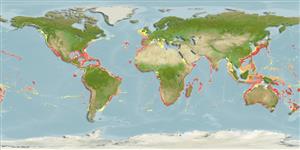Classification / Names
Common names from other countries
Main reference
Size / Weight / Age
Max length : 300 cm TL male/unsexed; (Ref. 5951); common length : 150 cm SL male/unsexed; (Ref. 6181); max. published weight: 63.5 kg (Ref. 4699)
Environment
Marine; benthopelagic; oceanodromous (Ref. 51243); depth range 100 - 800 m (Ref. 9302), usually 200 - 400 m (Ref. 6181)
Climate / Range
Subtropical, preferred 25°C (Ref. 107945); 55°N - 43°S, 180°W - 180°E (Ref. 6181)
Distribution
Short description
Dorsal
spines
(total): 13 - 15;
Dorsal
soft rays
(total): 15-18;
Anal
spines: 0;
Anal
soft rays: 15 - 18;
Vertebrae: 32. Skin very rough, scales interspersed with spinous bony tubercles. Mid-ventral (abdominal) keel on the ventral contour. Body is uniformly brown to dark brown, tips of the pectoral and pelvic fins black, margins of the second dorsal and anal fins white in young specimens.
IUCN Red List Status (Ref. 115185)
Threat to humans
Poisonous to eat (Ref. 4690)
Human uses
Fisheries: minor commercial; gamefish: yes
More information
ReferencesAquacultureAquaculture profileStrainsGeneticsAllele frequenciesHeritabilityDiseasesProcessingMass conversion
Tools
Special reports
Download XML
Internet sources
Estimates of some properties based on models
Phylogenetic diversity index
PD50 = 1.0000 many relatives (e.g. carps) 0.5 - 2.0 few relatives (e.g. lungfishes)
Trophic Level
4.2 ±0.57 se; Based on food items.
Resilience
Low, minimum population doubling time 4.5 - 14 years (Assuming tm>4)
Vulnerability
Very high vulnerability (85 of 100)
Price category
